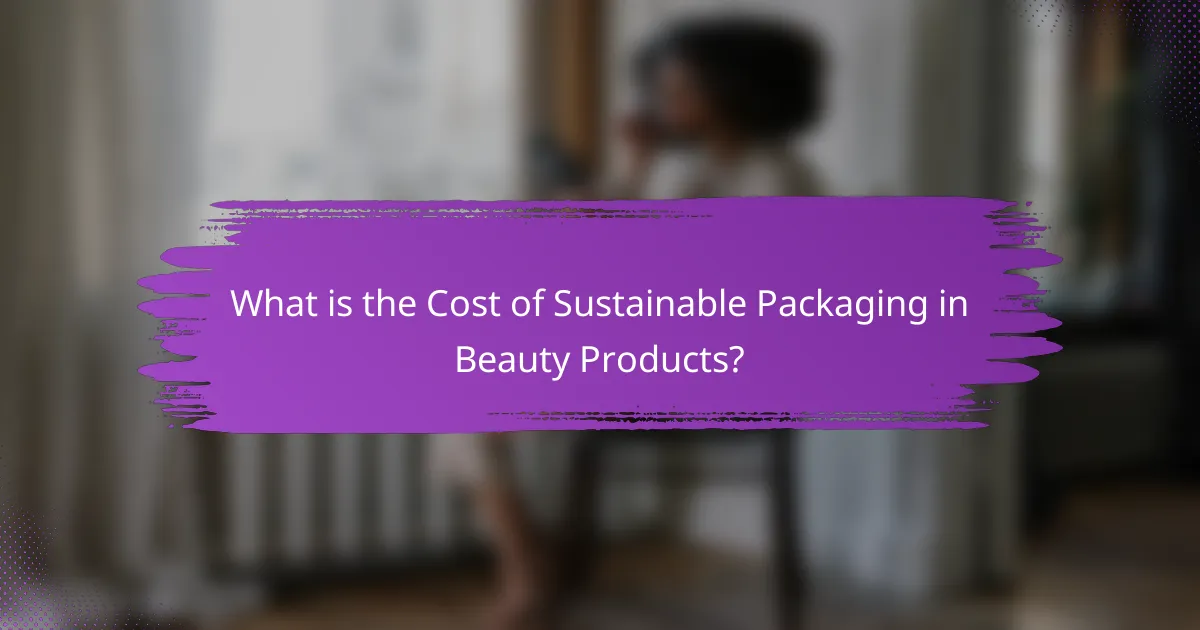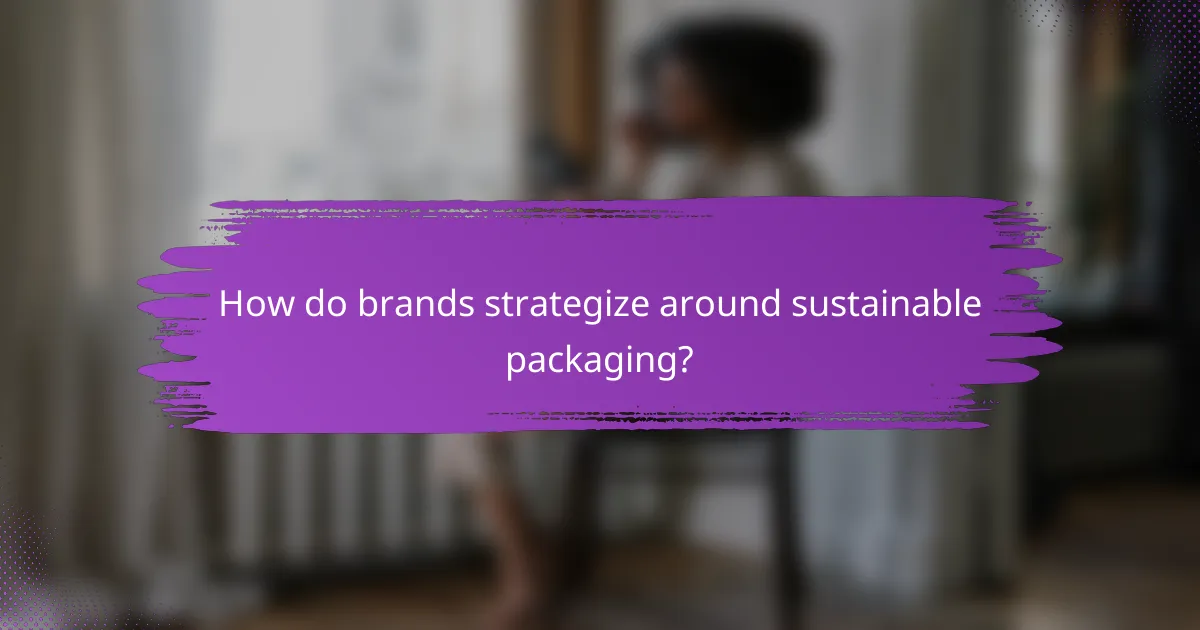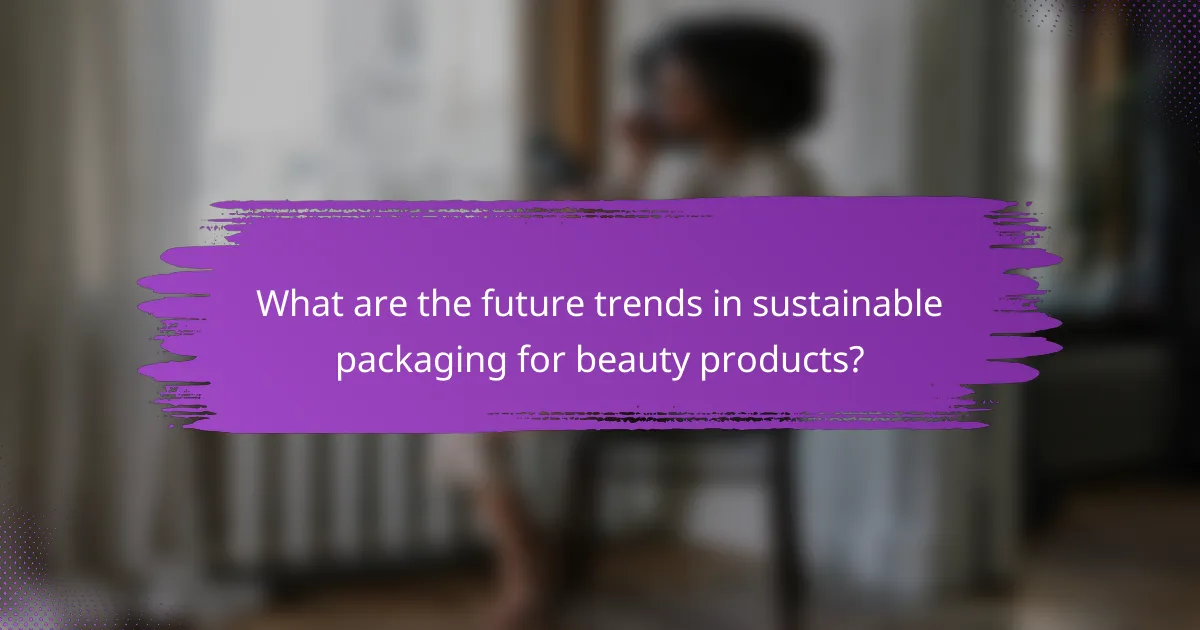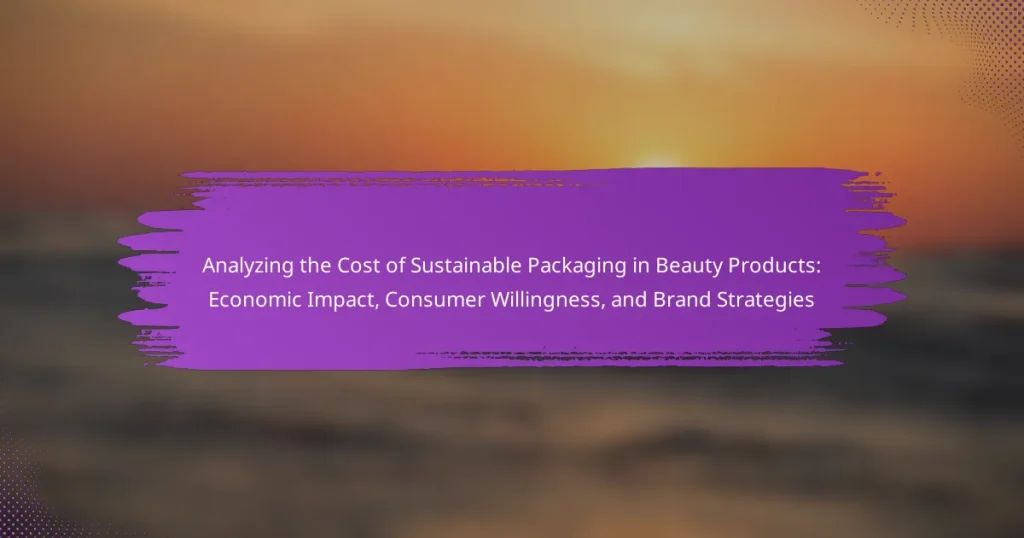The article examines the economic implications of sustainable packaging in beauty products, highlighting that the cost is typically 10% to 30% higher than conventional options due to the use of eco-friendly materials and innovative design processes. It discusses consumer willingness to pay a premium for sustainable packaging, with research indicating that 66% of consumers prioritize these options. The article also explores brand strategies for integrating sustainable practices, such as using biodegradable materials and reducing packaging size, which enhance brand loyalty and market competitiveness. Additionally, it addresses future trends, including the rise of refillable packaging systems and minimalistic designs, as the beauty industry shifts towards a circular economy model.

What is the Cost of Sustainable Packaging in Beauty Products?
The cost of sustainable packaging in beauty products typically ranges from 10% to 30% higher than conventional packaging. This increase is due to the use of eco-friendly materials and innovative design processes. For instance, brands may opt for biodegradable or recycled materials, which can be more expensive to source. Additionally, sustainable packaging often requires more investment in research and development. According to a 2021 study by McKinsey & Company, consumers are willing to pay a premium for sustainable options, which can offset some costs. Brands that adopt sustainable practices may also benefit from improved brand loyalty and market differentiation.
How is sustainable packaging defined in the beauty industry?
Sustainable packaging in the beauty industry is defined as packaging that minimizes environmental impact. It typically uses materials that are recyclable, biodegradable, or made from renewable resources. This type of packaging aims to reduce waste and carbon footprint. Many beauty brands are shifting to sustainable packaging to meet consumer demand for eco-friendly products. For instance, a survey by McKinsey & Company found that 66% of consumers are willing to pay more for sustainable brands. Additionally, sustainable packaging can enhance brand reputation and loyalty among environmentally conscious consumers.
What materials are commonly used in sustainable packaging?
Common materials used in sustainable packaging include recycled paper, cardboard, biodegradable plastics, and glass. Recycled paper and cardboard are widely used due to their renewability and recyclability. Biodegradable plastics, made from cornstarch or other natural materials, break down more easily than traditional plastics. Glass is reusable and recyclable, making it a preferred choice for many brands. These materials help reduce environmental impact and promote sustainability in packaging.
How does sustainable packaging differ from traditional packaging?
Sustainable packaging differs from traditional packaging primarily in its environmental impact. Sustainable packaging is designed to minimize waste and reduce carbon footprint. It often utilizes biodegradable, recyclable, or compostable materials. Traditional packaging typically relies on plastics and non-renewable resources. This results in higher levels of pollution and landfill waste. According to the Ellen MacArthur Foundation, only 14% of plastic packaging is recycled globally. Sustainable packaging aims to promote a circular economy. This approach helps conserve resources and protect ecosystems.
What are the economic impacts of sustainable packaging?
Sustainable packaging positively impacts the economy by reducing costs and increasing consumer demand. It lowers waste management expenses through recyclability and compostability. Companies adopting sustainable practices often see enhanced brand loyalty. A study by the Boston Consulting Group found that 75% of consumers prefer brands with sustainable packaging. This preference can lead to increased sales and market share. Additionally, sustainable packaging can create jobs in recycling and manufacturing sectors. Overall, these economic benefits contribute to a more sustainable market landscape.
How does the cost of sustainable packaging compare to conventional options?
Sustainable packaging generally costs more than conventional options. The price difference is often due to higher raw material costs and production processes. For example, sustainable materials like recycled paper or bioplastics can be pricier than traditional plastics. A study by Smithers Pira indicates that sustainable packaging can be 10-30% more expensive. However, many brands are willing to absorb these costs due to consumer demand for eco-friendly products. Additionally, the long-term savings from reduced waste disposal can offset initial expenses.
What are the long-term financial benefits of adopting sustainable packaging?
Adopting sustainable packaging leads to long-term financial benefits, including cost savings and increased consumer loyalty. Companies can reduce material costs by using recyclable or biodegradable materials. Sustainable packaging often requires less energy in production, leading to lower operational expenses. Additionally, brands that prioritize sustainability can attract environmentally conscious consumers. Research shows that 66% of consumers are willing to pay more for sustainable products. This willingness boosts sales and enhances brand reputation. Over time, these factors contribute to higher profit margins and market share. Sustainable practices can also mitigate risks related to regulatory changes and resource scarcity.
Why is consumer willingness important in the context of sustainable packaging?
Consumer willingness is crucial for the success of sustainable packaging. It drives demand for eco-friendly products. When consumers prefer sustainable options, brands are incentivized to adopt these practices. This shift can lead to a reduction in environmental impact. According to a study by Nielsen, 73% of global consumers are willing to change their consumption habits to reduce environmental impact. Therefore, consumer willingness directly influences market trends and encourages innovation in sustainable packaging solutions.
What factors influence consumer willingness to pay for sustainable packaging?
Consumer willingness to pay for sustainable packaging is influenced by several factors. Key factors include environmental concern, perceived value, and brand reputation. Consumers with higher environmental awareness are more likely to pay a premium for sustainable options. Research shows that 66% of global consumers are willing to pay more for sustainable brands (Nielsen, 2015). Additionally, perceived value relates to the benefits consumers associate with sustainable packaging, such as quality and safety. Brand reputation also plays a crucial role; companies known for sustainability often see increased consumer loyalty and willingness to pay more.
How does consumer perception of sustainability affect purchasing decisions?
Consumer perception of sustainability significantly influences purchasing decisions. When consumers view a brand as sustainable, they are more likely to choose its products. A 2021 Nielsen report found that 73% of global consumers would change their consumption habits to reduce environmental impact. This indicates a strong preference for sustainable options. Brands with sustainable practices often see increased customer loyalty. Additionally, consumers are willing to pay more for products perceived as environmentally friendly. Research by McKinsey shows that 60% of consumers are willing to pay a premium for sustainable products. This trend highlights the importance of sustainability in marketing strategies.

How do brands strategize around sustainable packaging?
Brands strategize around sustainable packaging by integrating eco-friendly materials and practices into their operations. They assess the lifecycle of packaging materials to minimize environmental impact. Many brands prioritize biodegradable, recyclable, or compostable materials. This approach aligns with consumer demand for sustainability. Research shows that 66% of consumers are willing to pay more for sustainable brands. Brands also focus on reducing packaging size to lower material use and waste. Collaborations with suppliers can enhance access to sustainable materials. Additionally, transparent communication about sustainability efforts builds consumer trust. These strategies collectively enhance brand reputation and market competitiveness.
What strategies are brands using to implement sustainable packaging?
Brands are using several strategies to implement sustainable packaging. They are shifting to biodegradable materials to reduce landfill waste. Many brands are adopting minimalist designs to decrease material usage. Some companies are utilizing recycled materials in their packaging to promote circular economy principles. Brands are also investing in innovative packaging technologies that enhance sustainability. They are offering refillable options to minimize single-use packaging. Additionally, brands are engaging consumers through educational campaigns about the importance of sustainable packaging. These strategies align with consumer demand for eco-friendly products, as studies show that 73% of consumers are willing to pay more for sustainable packaging.
How do brands communicate their sustainability efforts to consumers?
Brands communicate their sustainability efforts to consumers through transparent messaging and certifications. They often utilize eco-labels to indicate compliance with environmental standards. Many brands share detailed sustainability reports outlining their practices and goals. Social media platforms serve as effective channels for real-time engagement and updates. Visual storytelling through videos and infographics helps convey their commitment. Collaborations with environmental organizations enhance credibility and reach. Consumer feedback is increasingly integrated into sustainability narratives. Research shows that 66% of consumers are willing to pay more for sustainable brands, indicating a strong market demand for such communication.
What challenges do brands face when transitioning to sustainable packaging?
Brands face several challenges when transitioning to sustainable packaging. One major challenge is the higher costs associated with sustainable materials. These materials often have a premium price compared to traditional packaging options. Additionally, sourcing sustainable materials can lead to supply chain complexities. Brands may struggle to find reliable suppliers that can meet their sustainability standards.
Another challenge is the need for redesigning packaging. This process can require significant investment in research and development. Brands also face consumer skepticism regarding the effectiveness and environmental impact of sustainable packaging. Educating consumers on these benefits is essential but can be resource-intensive.
Regulatory compliance presents another hurdle. Brands must navigate varying regulations regarding sustainable packaging across different markets. Finally, there is often a lack of industry-wide standards for what qualifies as “sustainable.” This ambiguity can confuse brands and consumers alike.
What role does branding play in the success of sustainable packaging?
Branding significantly influences the success of sustainable packaging. Strong branding enhances consumer recognition and trust. Consumers are more likely to choose products with recognizable sustainable brands. Effective branding communicates a commitment to environmental responsibility. This can lead to increased sales and customer loyalty. Research shows that 66% of consumers prefer brands that are environmentally friendly. Thus, branding aligns with consumer values and purchasing decisions. Brands that invest in sustainable packaging can differentiate themselves in a competitive market. This differentiation can result in a positive brand image and higher market share.
How can effective branding enhance consumer trust in sustainable products?
Effective branding enhances consumer trust in sustainable products by creating a strong, recognizable identity. A consistent brand message communicates commitment to sustainability. This clarity helps consumers make informed choices. Research shows that 66% of consumers prefer brands that demonstrate environmental responsibility. Trust increases when brands provide transparent information about their practices. Effective branding also involves storytelling that resonates with consumers’ values. Engaging narratives about sustainability foster emotional connections. These connections lead to brand loyalty and repeat purchases. Brands that prioritize sustainability in their identity can differentiate themselves in a crowded market.
What are examples of successful brands utilizing sustainable packaging?
Examples of successful brands utilizing sustainable packaging include Unilever, Lush, and Coca-Cola. Unilever has committed to making all its plastic packaging recyclable, reusable, or compostable by 2025. Lush uses biodegradable materials and minimal packaging for its products. Coca-Cola aims to collect and recycle a bottle for every bottle sold by 2030. These brands demonstrate effective strategies in sustainable packaging, contributing to environmental conservation.

What are the future trends in sustainable packaging for beauty products?
Future trends in sustainable packaging for beauty products include increased use of biodegradable materials and innovative designs. Brands are shifting towards compostable and recyclable options. This change is driven by consumer demand for eco-friendly products. Research indicates that 72% of consumers prefer brands with sustainable packaging. Additionally, refillable packaging systems are gaining traction. These systems reduce waste and promote reuse. Companies are also exploring minimalistic packaging designs to lower material usage. Advances in technology enable the development of smart packaging that enhances user experience while being sustainable. Overall, the beauty industry is moving towards a circular economy model.
How is technology influencing sustainable packaging solutions?
Technology is significantly influencing sustainable packaging solutions by enabling the development of eco-friendly materials and efficient production processes. Innovations such as biodegradable plastics and plant-based materials reduce environmental impact. Advanced manufacturing techniques, like 3D printing, minimize waste and energy consumption. Smart packaging technologies enhance recycling by providing information on proper disposal methods. Data analytics optimizes supply chains, reducing carbon footprints. According to a report by Smithers Pira, the sustainable packaging market is projected to reach $500 billion by 2027. This growth is driven by consumer demand for environmentally responsible products. Companies are increasingly adopting these technologies to meet regulatory requirements and improve brand loyalty.
What innovations are emerging in sustainable packaging materials?
Innovations in sustainable packaging materials include biodegradable plastics, plant-based materials, and reusable packaging systems. Biodegradable plastics, made from natural sources, decompose more efficiently than traditional plastics. Plant-based materials, such as those derived from cornstarch or sugarcane, reduce reliance on fossil fuels. Reusable packaging systems encourage consumers to return containers for refill, minimizing waste. Additionally, advancements in water-soluble packaging offer alternatives for single-use items. Research indicates that these innovations can significantly lower environmental impact while meeting consumer demand for sustainability. Brands adopting these materials are responding to a growing market trend focused on eco-friendly practices.
How can brands leverage technology to improve sustainability?
Brands can leverage technology to improve sustainability by implementing innovative solutions like eco-friendly materials and efficient supply chain management. Advanced software can optimize logistics, reducing carbon footprints. Smart packaging technologies can enhance recyclability and minimize waste. Data analytics helps brands track resource consumption and identify areas for improvement. Renewable energy technologies can power production facilities, decreasing reliance on fossil fuels. Blockchain can enhance transparency in sourcing sustainable materials. According to a report by McKinsey, companies using these technologies can reduce emissions by up to 30%.
What best practices should brands follow for sustainable packaging?
Brands should prioritize using recyclable materials for sustainable packaging. This practice minimizes waste and encourages recycling. Brands can also opt for biodegradable materials that break down naturally, reducing environmental impact. Additionally, brands should design packaging that uses less material, which conserves resources. Implementing refillable packaging options can significantly reduce single-use waste. Brands must also communicate sustainability efforts clearly to consumers, fostering transparency. Collaborating with suppliers who prioritize sustainability enhances the overall impact. Finally, brands should regularly assess their packaging’s lifecycle to identify areas for improvement. These practices align with consumer preferences for eco-friendly products, driving brand loyalty.
What steps can brands take to assess their packaging sustainability?
Brands can assess their packaging sustainability by conducting a lifecycle assessment (LCA). LCA evaluates the environmental impacts of packaging from production to disposal. Brands should analyze materials used in packaging. Assessing whether materials are recyclable or biodegradable is crucial. Brands can also measure carbon footprint during production and transportation. Engaging with suppliers for sustainable sourcing practices is essential. Gathering consumer feedback on packaging preferences helps gauge sustainability perception. Finally, brands should benchmark against industry standards for sustainability. These steps ensure a comprehensive understanding of packaging sustainability.
How can brands effectively engage consumers in their sustainability journey?
Brands can effectively engage consumers in their sustainability journey by fostering transparency and education. Providing clear information about sustainable practices builds trust. Engaging storytelling about the brand’s sustainability efforts resonates with consumers. Interactive platforms, such as social media, encourage consumer participation. Brands can also implement loyalty programs that reward sustainable choices. Research shows that 66% of consumers are willing to pay more for sustainable brands. This willingness highlights the importance of aligning brand values with consumer expectations.
The main entity of this article is sustainable packaging in beauty products. The article analyzes the cost implications, which typically range from 10% to 30% higher than conventional options due to the use of eco-friendly materials and innovative designs. It explores consumer willingness to pay a premium for sustainable options, highlighting that 66% of consumers prefer brands with sustainable practices. Additionally, the article discusses the economic impact of sustainable packaging, brand strategies for implementation, and the role of technology in enhancing sustainability. Key materials, challenges, and future trends in sustainable packaging are also examined.


